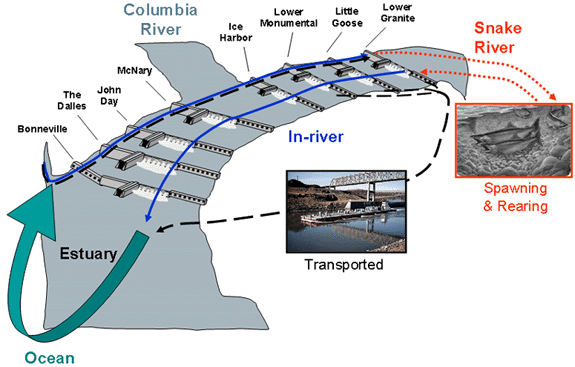CSMEP Harvest Monitoring and Evaluation Designs
Harvest monitoring is an essential component of salmonid recovery efforts to allow economically and culturally important fisheries to continue while ensuring impacts to ESA-listed stocks are kept within acceptable rates. Fisheries are the single activity fully within the control of fish managers and they cause direct and delayed-mortality losses to returning adult fish and are the subject of much scrutiny. A full accounting of fishery-related mortality is important to describing abundance and productivity of these stocks and quantifying population trends.
CSMEP's Harvest subgroup is focused on:
- understanding and describing the methods used to monitor these fisheries
- describing the accuracy and precision (where possible) of parameters used to quantify ESA impacts, and
- exploring alternative monitoring designs that could contribute to a better accounting of fishery related losses and improved population status and trend monitoring
Fisheries are characterized by species sought, seasonality, geography, and gear type. Columbia Basin fisheries can be separated into four major regional/gear categories:
- non-Indian commercial fisheries conducted downstream from Bonneville Dam
- treaty commercial, ceremonial, and subsistence fisheries conducted in the three reservoir areas bounded by Bonneville and McNary dams
- mainstem sport fisheries in the Columbia and Snake rivers
- tributary sport and treaty fisheries conducted in Columbia and Snake river tributaries
The CSMEP Harvest workgroup is developing generalized fishery models based on the current fishery impact models used by agency managers to assess fishing mortality of ESA -listed stocks. Within these models an impact is an ESU-specific mortality rate attributed to a specific fishery. Impact models incorporate all available fishery monitoring data, such as preseason and in-season run forecasts, harvest, release rates, post-release mortality rates, stock composition, and hatchery marking rates. These generalized models will be used to determine sensitivity of perceived impacts to changes in harvest monitoring designs by varying model input parameters within known or expected ranges. These sensitivity analyses will be used to evaluate the relative cost and precision of current and alternative harvest monitoring designs for assessing harvest impacts.
Harvest monitoring

Illustration of the different scales of interest for monitoring the effects of the hydrosystem on salmon survival rates: survival at individual projects, survival by different passage routes through the entire hydrosystem, post-Bonneville survival of different groups of fish, smolt to adult return rates back to Lower Granite Dam, and overall life cycle survival back to the spawning ground. Moving from smaller to larger scales results in more confounding from other factors (ocean conditions, hatcheries, harvest), but also provides an assessment of indirect effects over a larger portion of the life cycle. The CSMEP Hydro Subgroup is integrating monitoring designs with other CSMEP subgroups, particularly related to PIT-tagging.
Final Work Product Documents Associated with Hydrosystem Monitoring and Evaluation Designs
Technical Harvest Reports/Links
ISAB Report on Harvest Management of Columbia Basin Salmon and Steelhead